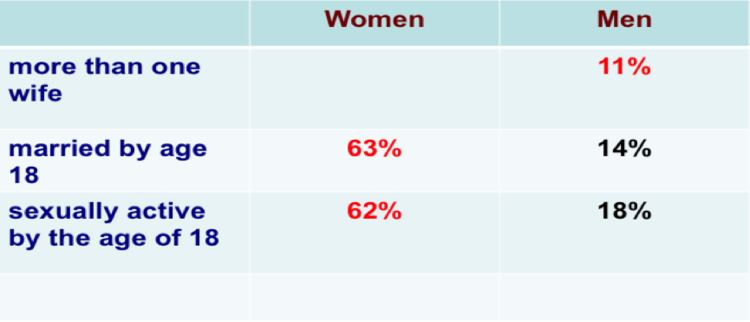 | ||
Women's health in Ethiopia can be broken down into several sections: general health status, women’s status, maternal health, women and HIV, harmful traditional practices, and violence against women.
Contents
Background
Ethiopia is the oldest independent and second most-populous country in Africa. A projection from the 2007 census, it has a total of 90 million inhabitants in 2015 (CSA 2015).
The sex ratio between male and female is almost equal; women in the reproductive age group constitute 23.4% of the population. The total fertility rate declined from 5.5 in 2000 to 4.1 in 2014.
General health status in Ethiopia
The average life expectancy for an Ethiopian has increased from 45 years in 1990 to 64 years in 2014, which is higher than the African average (58 years) but lower than the global average of 70 years. This makes Ethiopia one of the six countries that made top individual gains since 1990. The achievement is attributed to the dramatic drop in the under five mortality (U5MR) and an improvement in other socio-economic determinants of health. The U5MR has dropped from 204/1000 live births in 1990 to 64/1000 live births in 2013, the target for achieving MDG4 being 67/1000 live births. Thus Ethiopian has achieved the MDG 4 by the year 2013 well ahead of the proposed time for 2015.
Women’s status in Ethiopia
In Ethiopia, women of reproductive age constitute about a quarter of the entire population of 90 million. Around 80% of the labor force is engaged in agriculture, and 84% live in rural parts of the country. Poverty is multidimensional, and its impact is different on men and women. 43% of rural women aged 10 years and above are economically active, mostly in agriculture.
Maternal health
Good progress has been registered in maternal mortality reduction, a 69% reduction according to UN estimates from the 1400/100000 live births in 1990 to 420/100,000 live births in 2013.
Maternal wellbeing is crucial for the nations development. Majority of maternal deaths occur in the peripartum period. Deliveries attended by a skilled health care provider were shown to improve both maternal and neonatal survival. In Ethiopian most of the deliveries occur at home and unattended by skilled provider
Women and HIV
HIV Sero – prevalence in adults aged between 15-49years in Ethiopia is estimated at 1.5% [5.5% urban, 0.7% rural]. However, the Prevalence in women is about double than the prevalence in men, 1.9% versus 1%, respectively.
Harmful traditional practices
Seventy four percent of women had a FGM out of which, 6% have their vaginas sewn closed. Around 8% of all marriages occur after through abduction.
Violence against women
The most common forms of violence against women in Ethiopia include physical violence (intimate partner violence) and sexual violence. A study done in Kofele, (Oromia region, Arsi, Ethiopia) in 2004 showed the lifetime and the 12 months prevalence of physical violence among married women was 64% and 55%, respectively. Another study performed in North-west Ethiopia (Dabat High school) in 2005 revealed that sexual harassment was seen in 44% of the students and rape was experienced by 33.3% of sexually active students. A tertiary level of education the sexual violence was also alarmingly high as this was also confirmed by a study conducted at Addis Ababa University in 2004 on more than 600 students, where sexual harassment was experienced by 58% in life time and 41.8% in the last one year, rape was experienced by 12.7% of the students, and 27.5% of the student had escaped an attempted rape.
